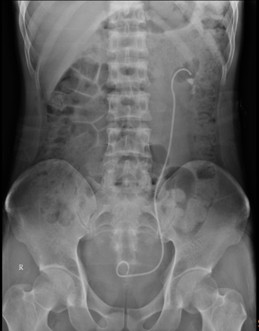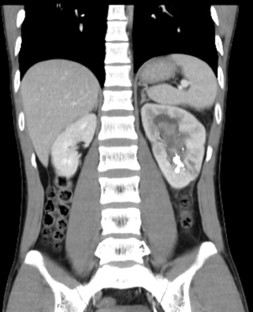經皮腎臟造廔取石之併發症分享
劉瑞文、吳佳璋
衛生福利部立雙和醫院 泌尿科
Complication of percutaneous nephrolithotomy case sharing
Liu Jui Wen, Chen Guan Zhou
Department of Urology, Shuang Ho hospital, Taipei Medical University, Taipei, Taiwan
Introduction: Percutaneous nephrolithotomy is standard procedure of large renal stone burden and staghorn stone according to EAU and AUA guideline. We are sharing one case about complication of the procedure and further management.
Case report: This 27 years old male patient denied chronic or systemic disease. There wasn’t family history of malignancy or hereditary disease. He just received left renal stone surgery about 1 week ago. According to his statement, clinical presentation was stable while discharged. However, hematuria and severe left flank pain was noted about 1 day ago. So he was brought to our emergent department for help. Physical examination showed left one small healed wound which previous nephrostomy tube wound without oozing or ecchymosis, severe left flank knocking pain. KUB showed left small residue renal stone and double J catheter was within correct position. CT scan showed blood clot within left renal pelvis and bladder. There was no unstable vital sign and active bleeding signs according to clinical presentation. Then operation as transurethral check bleeding was done smoothly. Bladder blood clot was washed out and no obvious bleeder was noted. Double J catheter was well drained and no fresh blood came out. His clinical presentation was stable after our management as activity modification, antibiotic, transamin and intravenous fluid supplement. Then he discharged after Foley catheter removal under stable condition, clean urine color and good self-voiding function.
 |
 |
|
Initial ER KUB
|
Initial ER CT
|
 |
|
|
Initial ER CT
|
|
Discussion: Large renal stone burden is hard to manage for every urologist. We consider outcome of procedure such as stone free rate, tubeless rate, patient clinical presentation, complication, admission duration. To this case, most important thing we want to discuss is complication of procedure. Complication of procedure was renal pelvis perforation, hydrothorax/ pneumothorax, perirenal hematoma, vascular or bowel damage, AV fistula or pseudo-aneurysm formation, hypovolemic shock, urinoma or urine leakage, sepsis, renal function impairment, wound infection. Total acute complication rate about 13-19% according to literature review, but mortality rate is very low as 0.5-1%. Perioperation management for complication are blood transfusion, open method for damage repaired, infection control protocol, even emergent nephrectomy. Back to this patient, his clinical course is stable after operation but we suspect A-V fistula or pseudo aneurysm formation. After heavy activity or some impact for the location of procedure, bleeding comes out from previous lesion. If there is no improving after TUR-check bleeding, we consider angiography and TAE for further management. His condition is stable after our management.
附件: